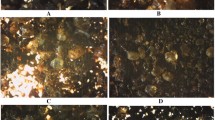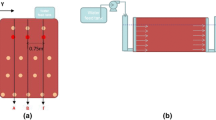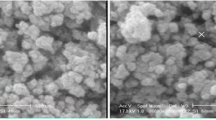Abstract
Chemical remediation of soil and groundwater containing hexavalent chromium (Cr(VI)) was carried out under batch and semi-batch conditions using different iron species: (Fe(II) (sulphate solution); Fe0 G (granulated elemental iron); ZVIne (non-stabilized zerovalent iron) and ZVIcol (colloidal zerovalent iron). ZVIcol was synthesized using different experimental conditions with carboxymethyl cellulose (CMC) and ultra-sound. Chemical analysis revealed that the contaminated soil (frank clay sandy texture) presented an average Cr(VI) concentration of 456 ± 35 mg kg−1. Remediation studies carried out under batch conditions indicated that 1.00 g of ZVIcol leads to a chemical reduction of ∼280 mg of Cr(VI). Considering the fractions of Cr(VI) present in soil (labile, exchangeable and insoluble), it was noted that after treatment with ZVIcol (semi-batch conditions and pH 5) only 2.5% of these species were not reduced. A comparative study using iron species was carried out in order to evaluate the reduction potentialities exhibited by ZVIcol. Results obtained under batch and semi-batch conditions indicate that application of ZVIcol for the “in situ” remediation of soil and groundwater containing Cr(VI) constitutes a promising technology.







Similar content being viewed by others
References
Calder, L. M. (1988). Chromium contamination of groundwater. In J. O. Niagru, & E. Nieboer (Eds.), Chromium in the natural and human environments (pp. 215–229). New York: Wiley & Sons.
Cao, J., & Zhang, W. X. (2006). Stabilization of chromium ore processing residue (COPR) with nanoscale iron particles. Journal of Hazardous Materials B, 132(2–3), 213–219. doi:10.1016/j.jhazmat.2005.09.008.
Domenico, P. A., & Schwartz, F. W. (1979). Physical and chemical hydrogeology (2nd ed.). New York: Wiley & Sons.
EPA (2000). In situ treatment of soil and groundwater contaminated with Chromium, Office of Research and Development, EPA/625/R-00/005, US, Environmental Protect Agency, Washington, D.C.
Franco, D. V., Da Silva, L. M., & Jardim, W. F. (2008). Evaluation of reducing agents for the remediation of soil containing hexavalent chromium. Environmental Science & Technology, submitted.
He, F., & Zhao, D. (2005). Preparation and characterization of a new class of starch-stabilized bimetallic nanoparticles for degradation of chlorinated hydrocarbons in water. Environmental Science & Technology, 39(9), 3314–3320. doi:10.1021/es048743y.
He, F., Zhao, D., Liu, J., & Roberts, C. B. (2007). Stabilization of Fe–Pd nanoparticles with sodium carboxymethyl cellulose for enhanced transport and dechlorination of trichloroethylene in soil and groundwater. Industrial & Engineering Chemistry Research, 46(1), 29–34. doi:10.1021/ie0610896.
James, B. R., Petura, J. C., Vitale, R. J., & Mussoline, G. R. (1995). Hexavalent chromium extraction from soils: a comparison of five methods. Environmental Science & Technology, 29(9), 2377–2381. doi:10.1021/es00009a033.
Kataby, G., Cojocaru, M., Prozorov, R., & Gedanken, A. (1999). Coating carboxylic acids on amorphous iron nanoparticles. Langmuir, 15(5), 1703–1708. doi:10.1021/la981001w.
Kataby, G., Prozorov, T., Koltypin, Y., Cohen, H., Sukenik, C., Ulman, A., et al. (1997). Self-assembled monolayer coating and amorphous iron and iron oxide nanoparticles: thermal stability and chemical reactivity studies. Langmuir, 13(23), 6151–6158. doi:10.1021/la960929q.
Kim, D. K., Mikhaylova, M., Zhang, Y., & Muhammed, M. (2003). Protective coating of superamagnetic iron oxide nanoparticles. Chemistry of Materials, 15(8), 1617–1627. doi:10.1021/cm021349j.
Kimbrough, D. E., Cohen, Y., Winer, A. M., Creelman, L., & Mabuni, C. (1999). A critical assessment of chromium in the environment. Critical Reviews in Environmental Science and Technology, 29(1), 1–46. doi:10.1080/10643389991259164.
Magdassi, S., Bassa, A., Vinetsky, Y., & Kamyshny, A. (2003). Silver nanoparticles as pigments for water-based ink-jet inks. Chemistry of Materials, 15(11), 2208–2217. doi:10.1021/cm021804b.
Suslick, K. S., Fang, M., & Hycon, T. (1996). Sonochemical synthesis of iron colloids. Journal of the American Chemical Society, 118(47), 11960–11961. doi:10.1021/ja961807n.
Palmer, C. D., & Wittbrodt, P. R. (1991). Processes affecting the remediation of chromium-contaminated sites. Environmental Health and Perspectives, 92, 25–40.
Ponder, S. M., Darab, J. G., & Mallouk, T. E. (2000). Remediation of Cr(VI) e Pb(II) aqueous solutions using supported, nanoscale zero-valent iron. Environmental Science & Technology, 34(12), 2564–2569. doi:10.1021/es9911420.
Schrick, B., Hydutsky, B. W., Blough, J. L., & Mallouk, T. E. (2004). Delivery vehicles for zerovalent metal nanoparticles in soil and groundwater. Chemistry of Materials, 16(11), 2187–2193. doi:10.1021/cm0218108.
Seaman, J. C., Bertsch, P. M., & Schwallie, L. (1999). In situ Cr(VI) reduction within coarse-textured, oxide-coated soil and aquifer systems using Fe(II) solutions. Environmental Science & Technology, 33(6), 938–944. doi:10.1021/es980546+.
Si, S., Kotal, A., Mandal, T., Giri, S., Nakamura, H., & Kohara, T. (2004). Size-controlled synthesis of magnetite nanoparticles in the presence of polyelectrolytes. Chemistry of Materials, 16(18), 3489–3496. doi:10.1021/cm049205n.
Su, C., & Ludwig, R. D. (2005). Treatment of hexavalent chromium in chromite ore processing solid waste using a mixed reductant solution of ferrous sulfate and sodium dithionite. Environmental Science & Technology, 39(16), 6208–6216. doi:10.1021/es050185f.
Sun, S., & Zeng, H. (2002). Size-controlled synthesis of magnetic nanoparticles. Journal of the American Chemical Society, 124(28), 8204–8205. doi:10.1021/ja026501x.
Tokunaga, T. K., Wan, J., Firestone, M. K., Hazen, T. C., Schwartz, E., Sutton, S. R., et al. (2001). Chromium diffusion and reduction in soil aggregates. Environmental Science & Technology, 35(15), 3196–3174. doi:10.1021/es010523m.
Xu, Y., & Zhao, D. (2007). Reductive immobilization of chromate in water and soil using stabilized iron nanoparticles. Water Research, 41(10), 2101–2108. doi:10.1016/j.watres.2007.02.037.
Zhang, W. X., Wang, C. B., & Lien, H. L. (1998). Treatment of chlorinated organic contaminants with nanoscale bimetallic particles. Catalysis Today, 40(4), 387–395. doi:10.1016/S0920-5861(98)00067-4.
Acknowledgements
The authors wish to thank the National Scientific Council for Research and Development (CNPq—Brazil) and Dr. Carol Collins for her technical assistance with the English.
Author information
Authors and Affiliations
Corresponding author
Glossary
- MCV
-
Maximum concentration value for Cr(VI)
- SGW
-
Synthetic groundwater
- ZVIne
-
Non-stabilized zerovalent iron
- ZVIcol
-
Colloidal zerovalent iron stabilized using CMC
- Fe0 G
-
Granulated zerovalent iron
- Fe(II)
-
Ferrous sulfate solution
- CMC
-
Carboxymethyl cellulose
- PV
-
Pore volume (−)
- G
-
Volumetric flow rate (ml min−1)
- ν
-
Linear velocity of the fluid (cm h−1)
- k VD
-
Volumetric mass dispersion coefficient (h−1)
- k obs
-
Pseudo-first order kinetic rate constant for the redox reaction (h−1)
- k obs*
-
Overall pseudo-first order kinetic rate constant for the redox reaction (h−1)
Rights and permissions
About this article
Cite this article
Franco, D.V., Da Silva, L.M. & Jardim, W.F. Reduction of Hexavalent Chromium in Soil and Ground Water Using Zero-Valent Iron Under Batch and Semi-Batch Conditions. Water Air Soil Pollut 197, 49–60 (2009). https://doi.org/10.1007/s11270-008-9790-0
Received:
Accepted:
Published:
Issue Date:
DOI: https://doi.org/10.1007/s11270-008-9790-0




